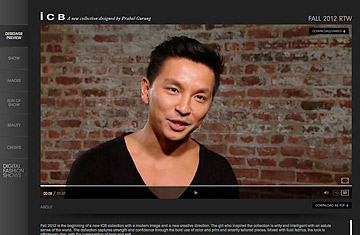
Between live streams of runway shows and perpetual Twitter updates from bloggers and designers alike, you no longer have to physically attend shows in Manhattan to see the New York Fashion Week collections being presented in real time. Just scan the front row at a fashion show and you'll see that coveted spots formerly reserved for magazine editors and celebrities are now also filled by fashion bloggers catering to legions of followers awaiting their every update.
This season, KCD, the international fashion public relations and production agency, introduced the first of its online-only shows with designer Prabal Gurung's collaboration with Japanese retailer ICB label. The shows, which are translated into different languages for overseas editors, have been designed for over-booked editors and buyers and are available by invitation only. Editors get a pre-taped runway show with online-embedding capabilities, high-resolution photos, interviews of the designer and behind-the-scenes footage of hair and makeup.
"The digital show format is a tool that will change the landscape of fashion week and allow us to see fashion shows through a different lens," says Gurung, whose web-exclusive show premiered on Feb. 15. "Aside from the convenience of it, the way it is formatted really allows the audience to experience the show from all angles, as well as from backstage."
According to KCD co-president Ed Filipowski, the formula presents a more democratic approach to fashion. "Very few editors get access to the designer's inspiration and very few get backstage beauty access," he says. "But here, all 500 guests have the same access."
And with the advent of fashion bloggers and writers for online publications, the whole scene has become far more digital and social with minute to minute updates from almost every show. Blogger Bryan Grey-Yambao, better known to fans as Bryanboy, garners 1.5 million pageviews a month on his blog, and he frequently uses his website to give readers an inside peek of the notoriously-private industry, from discussing Peter Som's new line with the designer over dinner to having Marc Jacobs name a green ostrich bag from his fall-winter 2008 collection "BB" in his honor. "Designers love the idea of making fashion more democratic and being able to reach a new audience instantly," he says. "If I send a tweet, within a few seconds readers will be responding and it engages them with the designer."
Supermodel Coco Rocha recently switched to Facebook Timeline to increase her visibility and fan interaction. The change has tripled her followers since users can now "subscribe" to her activities. "It's not only great for my career, but it allows me to speak for myself," she says. "As models, we are known for our cheekbones rather than what we have to say, but I can really reach out to so many people with social media."
These new initiatives are building on digital innovations first introduced during the spring-summer season of New York Fashion Week 2010. That year, a venue change from Bryant Park to Lincoln Center offered improved cell phone and wi-fi reception as well as kiosks for guests to check into shows electronically, instead of presenting the usual printed invites. Although the transition was not unanimously welcomed, many bloggers and online editors said they made reporting back to readers easier.
Which is all good news for the legions of fashionistas out there who can never be too far ahead of the curve.
